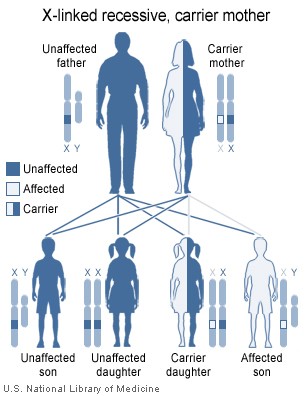Sex linkage: Difference between revisions
No edit summary |
No edit summary |
||
| Line 1: | Line 1: | ||
| ⚫ | |||
Not all [[geneotypes]] are linked to [[sex]]. |
|||
| ⚫ | In such cases there is a homogametic sex and a heterogametic sex. In |
||
| ⚫ | |||
| ⚫ | In such cases there is a homogametic sex and a heterogametic sex. In [[mammal]]s the homogametic sex is [[female]] (XX) and the heterogametic sex is male (XY), thus the sex linked genes are carried on the [[X chromosome]]. In [[bird]]s and in some insects the homogametic sex is male. In regards to [[duck]]s, a [[drake]] has ZZ chromosomes, with females ZW, sex-linked any recessive sex-linked genes are at least in part on the Z chromosome, and "male" and "female" are exchanged for [[human]]s. |
||
Dominant sex-linked genes are still thought to be relativly rare. Potentially expressed in both sexes, a sex preference may still exist. |
Dominant sex-linked genes are still thought to be relativly rare. Potentially expressed in both sexes, a sex preference may still exist. |
||
Revision as of 20:46, 11 November 2006
Not all geneotypes are linked to sex.
Sex linkage is the phenotypic expression of an allele that is dependent on the gender of the individual and is directly tied to the sex chromosomes.
In such cases there is a homogametic sex and a heterogametic sex. In mammals the homogametic sex is female (XX) and the heterogametic sex is male (XY), thus the sex linked genes are carried on the X chromosome. In birds and in some insects the homogametic sex is male. In regards to ducks, a drake has ZZ chromosomes, with females ZW, sex-linked any recessive sex-linked genes are at least in part on the Z chromosome, and "male" and "female" are exchanged for humans.
Dominant sex-linked genes are still thought to be relativly rare. Potentially expressed in both sexes, a sex preference may still exist.
X-linked recessive genes are expressed in all heterogametics, but only those homogametics that are homozygous for the recessive allele. An example is the sex-linked recessive: horns in sheep that appear only in males. The recessive phenotypes of such genes are more common in males than in females; to be precise, the incidence in females is the square of that in males (squaring a faction between 0% & 100% gives an outcome closer to 0 % than it was before), so if 19/20 of the male population are not green-blind and 1/20 of the male population are green-blind then 1/400 of the female population are and 399/400 are not. (AIS does not follow this rule because it interferes with reproduction.)

Sex-linked traits are inherited through chains of carrier mothers. That is, a girl, her mother, and her matternal grand-mother all are carriers, while some of their sons probably have the trait if they have about five sons.
Sex-linked traits in humans
Traits begining with A
X-linked dominant
X-linked recessive
- Adrenoleukodystrophy
- Androgen insensitivity syndrome
- Barth syndrome
- Becker's muscular dystrophy
- Color blindness: Red and green
- Duchenne muscular dystrophy
- Fragile X syndrome
- G6PD deficiency
- Hemophilia
- Kennedy disease
- Lesch-Nyhan syndrome
- Ornithine transcarbamylase deficiency
- Wiskott-Aldrich syndrome
- X-linked agammaglobulinemia
- X-linked ichthyosis
- X-linked form of centronuclear myopathy or myotubular myopathy
Y-linked
Sex-linked traits in other mammals
- Calico or tortoiseshell cats, those which have orange-and-black fur.
